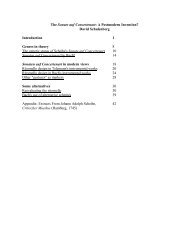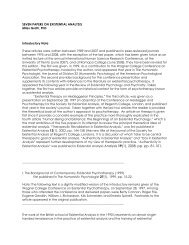download
download
download
Create successful ePaper yourself
Turn your PDF publications into a flip-book with our unique Google optimized e-Paper software.
Schulenberg: Froberger, AMS 2006, p. 4<br />
corresponding to the visual one drawn immediately beside it in the manuscript, as in figure 1b. 7<br />
The association between heaven and an ascending scale may seem obvious. But it is good<br />
to have this documentary confirmation that a seventeenth-century musician would have made the<br />
connection. Other evidence for associations of this type occurs in an exchange of letters between<br />
Descartes and Mersenne. In their discussion, which concerns a musical competition between two<br />
composers, both assume that musical intervals have specific, concrete emotional meanings. For<br />
instance, half steps and minor thirds are sad, whereas fifths and major sixths are full of energy.<br />
Descending intervals represent decline, ascending ones are lively. Later writers would continue<br />
to attach meanings to intervals. Werckmeister held that the octave could represent the son of<br />
8 God. Bacilly, in his treatise on singing, invokes precise affects or passions (passions) in<br />
9<br />
describing the most minute details of diction and ornamentation. Each writer in effect takes for<br />
granted a semiotics of expression and representation that relates the musical surface to specific<br />
emotions and concrete images.<br />
It would not be surprising if Froberger shared generally held views on the emotional<br />
significance of intervals and ornaments. To be sure, the expressive profundity of his music comes<br />
not from the mechanical application of rules governing the musical surface, but rather from<br />
deeper compositional elements: the ingenious chromatic modulations, the beautifully nuanced<br />
melodic embellishment, and the varied rhythmic pacing that gives each piece a distinctive<br />
dynamic shape. Yet Froberger's music does incorporate mechanical signifiers such as chromatic<br />
intervals, or ascending and descending scales. These permit not only the naive sort of analysis<br />
offered by Mersenne and Descartes, but also the narrative programs that I will discuss shortly.<br />
From these signs and symbols, it is a relatively small step to the programmatic keyboard sonatas<br />
of Johann Kuhnau or the theory of musical expression put forth by Johann Mattheson. 10<br />
Already during his lifetime, Froberger may have been recognized for the uniquely<br />
expressive, even autobiographical character of certain compositions. In the dedication to the<br />
1656 autograph, he tells the emperor that his works “derive from emotions that the vicissitudes of<br />
7<br />
For a well-known account of a recurring motive as “emblem,” see Ellen Rosand, “The<br />
Descending Tetrachord: An Emblem of Lament,” Musical Quarterly 65 (1979): 346–59.<br />
100.<br />
8<br />
Andreas Werckmeister, Musicalische Paradoxal-Discourse (Quedlinburg, 1707), 92,<br />
9<br />
For instance, urging the singer to avoid a trill at a certain moment, Bacilly argues that “it<br />
would remove all the sweetness that the composer intends.” See Bénigne de Bacilly, Remarques<br />
curieuses sur l'art de bien chanter (Paris, 1668; translation and commentary by Austin B.<br />
Caswell as A Commentary upon the Art of Proper Singing, New York: Institute of Mediaeval<br />
Music, 1968), 174.<br />
10 On Mattheson's theory of musical expression, see Peter Kivy, Sound Sentiment: An<br />
Essay on the Musical Emotions, Including the Complete Text of The Corded Shell (Philadelphia:<br />
Temple University Press, 1989), 39–43. Kivy shows that Mattheson's was not a naive “arousal”<br />
theory but rather involved the listener's “cognitive response” to musical signs such as intervals.















